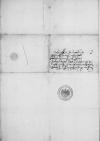Dem durchlauchten, hochgebornn fursten und hern, hern ⌊Albrechten⌋, vonn Gots gnaden margraffen zu ⌊Branden burg⌋ etc. herczogenn in ⌊Preussennn⌋ etc. meymm gnedigen, liben hern
Durchlauchter, hochgeborner furst, gnediger, liberr herr. / Meyn freuntliche, willige dienst zuvorann. /
Im negsten hab ich Ewer Gnaden ⌊⌋, das ich durch meynenn bruder, / den ich hie zu Ewer Gnaden geschickt, / etliche muntliche werbunge wolde thun / in freuntlicher zuvorsicht, Ewer Gnaden werd die guttlich von mir uff nhemenn und vorsthenn / und sich dar innenn, wie meynn gnediger, liber herr beweisenn, / derhalbenn ich Ewer Gnaden bit, wolt dissenn meynenn bruder von meynen wegenn guttlich vorhörenn / und im in demm, / was her in meynemm nhamenn Ewer Gnaden wirt anczeigenn, / nicht anders als mir selbst gloubenn gebenn / und was her Ewer Gnaden und derselbtigen ⌊furstynnenn⌋ / kleynn, geringe werck vonn meynenn wegenn wirt vor ehrenn / freuntlich und gunstlich uff nhomenn und nicht das gegebenn, / sunder meynn dinstlich gemut und willenn ermessenn, / do nebenn ouch meynn svoger, denn hern ⌊doctor⌋, Ewer Gnaden diner, / befholenn habenn / und meynn gnediger, liber herr seynn und bleiben. / Got der almechtige enthalde Ewer Gnaden in langweriger gesuntheit und glukseligemm zunhemenn lange zceit. /

